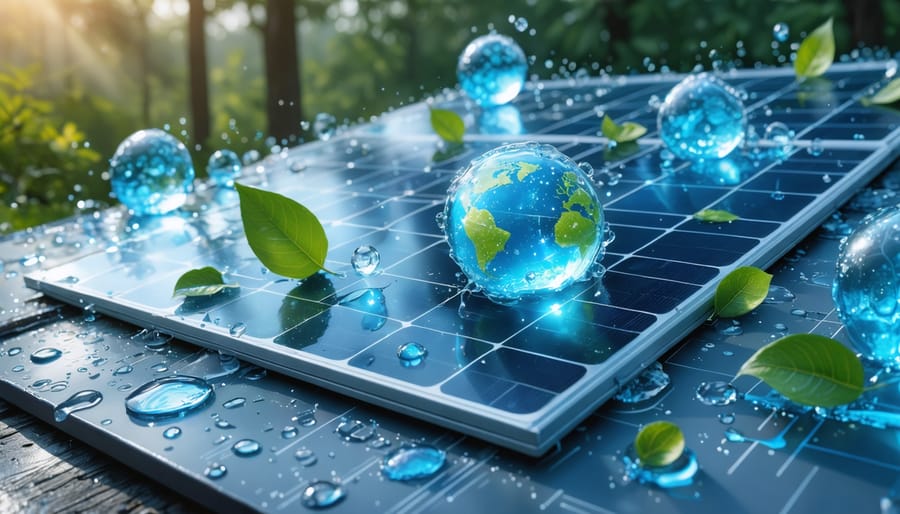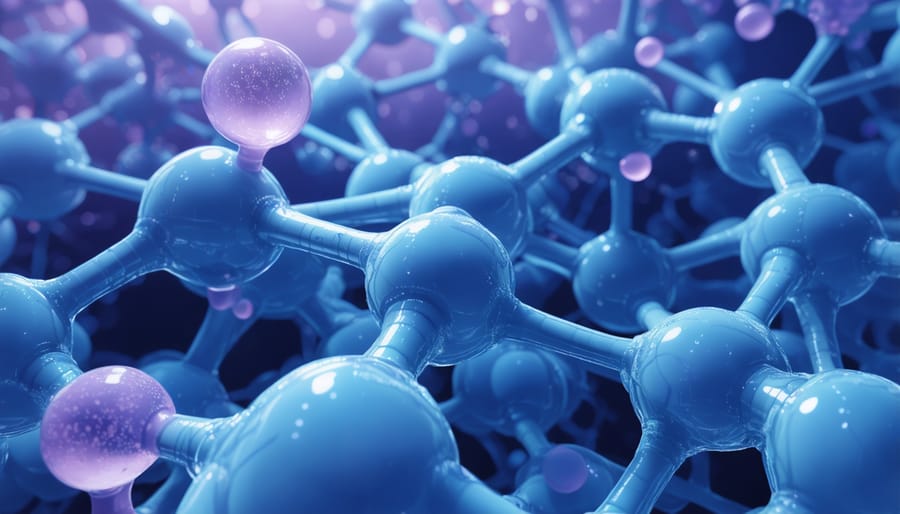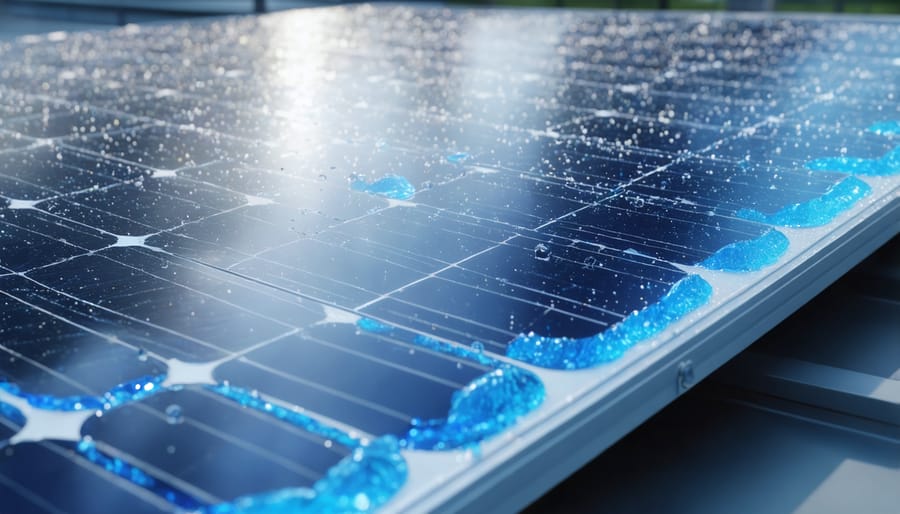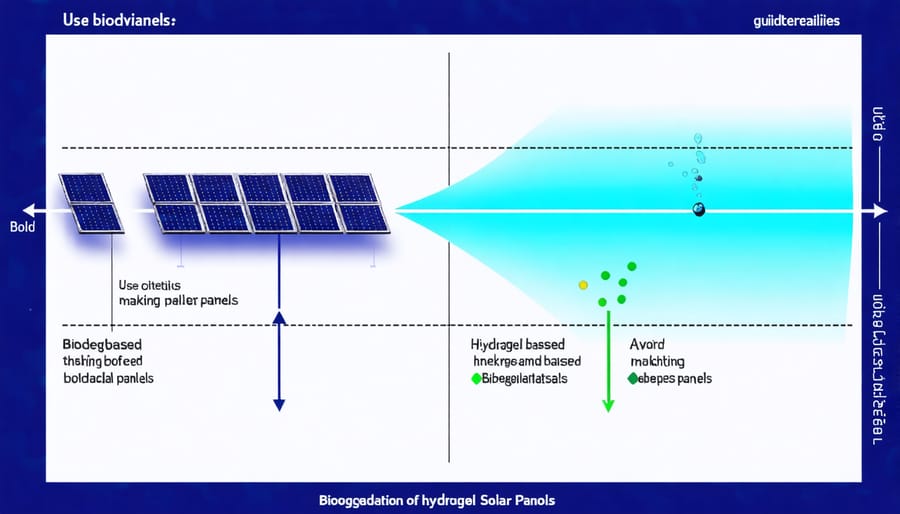Hydrogel Revolutionizes Solar Panel Recycling: The Future is Biodegradable

Biodegradable hydrogels represent a groundbreaking frontier in sustainable materials science, offering unprecedented solutions for environmental challenges across Europe and beyond. These remarkable substances, composed of cross-linked hydrophilic polymer networks, naturally decompose into harmless components while maintaining their exceptional functionality during their service life. As climate concerns intensify and European regulations push for greener alternatives, biodegradable hydrogels emerge as a vital innovation in fields ranging from agriculture to medical applications. Their unique ability to absorb vast quantities of water while maintaining structural integrity, combined with their eco-friendly decomposition, positions them as a cornerstone technology in the transition toward circular economy practices. This revolutionary material class not only addresses immediate environmental concerns but also opens new possibilities for sustainable industrial applications, perfectly aligning with the EU’s ambitious sustainability goals for 2030 and beyond.
Understanding Hydrogel Technology in Solar Applications
What Makes Hydrogels Biodegradable?
The biodegradability of hydrogels stems from their unique chemical composition and structure, which allows them to break down naturally over time. These breakthrough solar materials typically consist of cross-linked polymer networks that can absorb and retain significant amounts of water while maintaining their three-dimensional structure.
The biodegradation process occurs through various mechanisms, including hydrolysis, enzymatic breakdown, and microbial activity. The polymer chains contain strategically placed biodegradable bonds that can be cleaved by natural processes. When exposed to environmental conditions, water molecules penetrate the hydrogel structure, initiating hydrolysis of these bonds. Simultaneously, soil microorganisms recognize the natural polymer components and begin breaking them down into simpler compounds.
What makes this process particularly efficient is the hydrogel’s high water content and porous structure, which provides easy access for degrading agents. The end products of this decomposition are typically water, carbon dioxide, and biomass – all environmentally benign substances that can be naturally reintegrated into ecological cycles, making hydrogels an excellent choice for sustainable applications.

Key Benefits for Solar Panel Design
Hydrogel biodegradable technology brings several groundbreaking advantages to solar panel design, particularly in European climate conditions. The material’s exceptional flexibility allows panels to maintain optimal performance even under varying weather conditions, reducing the risk of damage from thermal stress and physical impact.
A key benefit is the enhanced durability these panels offer, with the hydrogel layer providing superior protection against UV radiation and environmental factors. This translates to extended panel lifespan and sustained efficiency, making them a cost-effective choice for long-term energy solutions.
The environmental impact is particularly noteworthy, as these panels address end-of-life concerns that traditional solar installations face. When decommissioned, the biodegradable components naturally decompose without leaving harmful residues, significantly reducing waste management challenges and environmental footprint.
Moreover, the innovative hydrogel technology improves panel efficiency by maintaining optimal operating temperatures through its unique moisture-retention properties. This feature is especially valuable during peak summer months, when conventional panels typically experience performance losses due to overheating.
For European installations, this technology aligns perfectly with EU sustainability directives while offering practical benefits in terms of maintenance and longevity.
Implementation in Modern Solar Panel Manufacturing

Current Applications and Innovations
Hydrogel technology is making remarkable strides in solar applications, particularly through sustainable manufacturing practices that enhance both efficiency and environmental compatibility. Current innovations include self-cleaning solar panel coatings that utilize hydrogel’s water-retention properties to maintain optimal performance while reducing maintenance needs.
In Europe, several research institutions have successfully developed biodegradable hydrogel-based cooling systems for solar panels, addressing the critical issue of temperature-related efficiency losses. These systems can improve panel efficiency by up to 15% during peak summer conditions while naturally decomposing at the end of their lifecycle.
Another groundbreaking application involves hydrogel-enhanced energy storage systems that complement solar installations. These systems utilize biodegradable hydrogels to create more sustainable battery components, offering improved capacity and reduced environmental impact compared to traditional storage solutions.
The integration of smart hydrogel technology in solar tracking systems is also gaining traction. These systems respond to environmental conditions, automatically adjusting their properties to optimize light absorption and heat management. This innovation particularly benefits regions with variable climate conditions, common across European territories.
Current research focuses on developing hybrid hydrogel materials that combine enhanced durability with complete biodegradability, ensuring both performance and environmental responsibility in solar energy applications.
European Manufacturing Standards
In the European Union, the manufacturing of biodegradable hydrogels is governed by stringent standards established by the European Committee for Standardization (CEN). These regulations ensure consistent quality and environmental safety across all member states. Manufacturers must comply with EN 13432, the primary standard for biodegradable materials, which requires products to decompose by at least 90% within six months under controlled conditions.
Quality control measures include rigorous testing for chemical composition, degradation rates, and environmental impact. The EN ISO 14851 and EN ISO 14852 standards specifically address the evaluation of biodegradability in aqueous environments, crucial for hydrogel applications. Additionally, manufacturers must obtain certification from accredited bodies to verify their compliance with these standards.
The European Chemicals Agency (ECHA) maintains oversight of raw materials used in hydrogel production through the REACH regulation, ensuring all components meet safety and environmental criteria. Regular audits and testing procedures verify that manufacturers maintain consistent production quality and adhere to biodegradability requirements.
Recent innovations in manufacturing processes have led to enhanced standardization methods, particularly for smart hydrogels used in agricultural and medical applications. These developments have prompted updates to existing standards, ensuring regulations keep pace with technological advancement while maintaining Europe’s leadership in sustainable material production.
Environmental Impact and Sustainability
End-of-Life Management
The end-of-life management of biodegradable hydrogels represents a significant advantage over conventional materials, particularly in environmental sustainability. These innovative materials can be processed through industrial composting facilities, where controlled conditions of temperature, humidity, and microbial activity facilitate their decomposition into harmless constituents like water, carbon dioxide, and biomass.
For commercial applications, hydrogels can be collected and processed through specialised recycling streams that separate them from other materials. The decomposition process typically takes between three to six months, depending on the specific hydrogel composition and environmental conditions. Many European waste management facilities are now equipped to handle these materials effectively.
It’s essential to note that while biodegradable hydrogels naturally decompose, proper disposal practices should still be followed. Users should verify local recycling guidelines, as some facilities may require specific sorting or preparation methods. Industries utilising these materials often implement closed-loop systems, where waste hydrogels are collected and processed in dedicated facilities.
The biodegradation process leaves no toxic residues or microplastics, aligning perfectly with European Union’s circular economy initiatives and waste reduction targets. This clean decomposition profile makes biodegradable hydrogels particularly valuable in applications where material recovery might be challenging or impractical.

Carbon Footprint Reduction
Implementing biodegradable hydrogel technology in solar panel manufacturing demonstrates significant environmental benefits through measurable carbon footprint reduction. Studies show that replacing traditional polymer-based components with hydrogel alternatives can reduce the solar panel carbon footprint by up to 27% during the production phase.
Quantitative analysis reveals that for every square meter of solar panels produced using biodegradable hydrogel components, approximately 12.3 kg of CO2 emissions are avoided compared to conventional manufacturing methods. This reduction stems from lower energy requirements during production and the elimination of petroleum-based materials.
The environmental impact extends beyond manufacturing. When considering the entire lifecycle, hydrogel-based panels contribute to a 31% decrease in carbon emissions during disposal phases, as they naturally decompose without releasing harmful substances. European manufacturing facilities implementing this technology have reported annual carbon savings equivalent to removing 850 passenger vehicles from the road per facility.
Furthermore, the water-retention properties of hydrogels reduce cleaning frequency by 40%, resulting in additional carbon savings through decreased maintenance requirements and extended panel lifespan. These combined benefits make biodegradable hydrogels a crucial innovation for sustainable solar energy development.
Future Prospects and Development
The future of biodegradable hydrogels shows remarkable promise, with ongoing research focused on enhancing their sustainability and performance characteristics. Scientists are developing advanced formulations that combine improved mechanical strength with faster degradation rates, making them increasingly viable for various industrial and medical applications.
Market analysts project significant growth in the biodegradable hydrogel sector, with an estimated annual growth rate of 14% through 2030. This expansion is driven by increasing environmental regulations and growing consumer demand for sustainable materials, particularly in European markets where circular economy initiatives are gaining momentum.
Emerging innovations include smart hydrogels that respond to specific environmental triggers, self-healing variants that extend product lifespans, and hybrid materials that combine hydrogels with natural fibres for enhanced functionality. Research institutions across Europe are developing hydrogels with programmable degradation rates, allowing for more precise control over their lifecycle.
Industrial applications are expected to diversify, with new developments in agricultural water retention systems, sustainable packaging solutions, and renewable energy storage. The medical sector continues to be a significant driver of innovation, with advances in tissue engineering and drug delivery systems utilizing biodegradable hydrogels.
These developments align with the European Union’s sustainability goals and circular economy initiatives, positioning biodegradable hydrogels as a key material in the transition towards more environmentally responsible technologies.
Hydrogel biodegradable technology represents a significant leap forward in sustainable solar development, offering a promising solution to the environmental challenges faced by traditional solar panel systems. By combining advanced material science with eco-conscious design, these innovative hydrogels provide enhanced efficiency while ensuring end-of-life sustainability. The technology’s ability to naturally decompose after use addresses the growing concern of solar panel waste, aligning perfectly with European Union’s circular economy goals. As we move towards a more sustainable future, biodegradable hydrogels demonstrate how innovation can successfully balance technological advancement with environmental responsibility. This breakthrough not only supports the transition to cleaner energy but also sets new standards for sustainable manufacturing in the solar industry, making it a crucial component in our journey towards a greener tomorrow.
Leave a Reply